
June 2003
Background | Oil | Natural Gas | Coal | Electricity | Profile | Links
Portugal
Portugal's energy imports are expected to increase significantly
in coming years, as the country lacks domestic resources for energy production.
Note: The information contained in this report is the best available as of June 2003 and is subject to change.
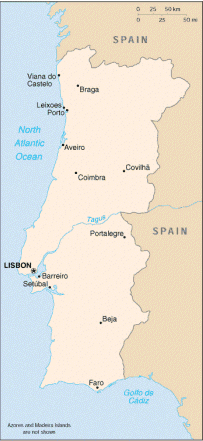 BACKGROUND
BACKGROUND
Portugal is a member of the European Union (EU) and the common European
currency, the euro. Portugal is a relatively poor country economically
in comparison to its neighbors, with the lowest nominal per-capita GDP
of all EU member states in 2002. However, since joining the EU, the country's
economy has expanded, with an average real economic growth rate of 3.7%
per year from 1986 to 2000. Funds to invest in the country's infrastructure
received from the European Commission have helped contribute to Portugal's
successful economic performance.
Before Portugal's newly-elected prime minister, José Manuel Durão
Barroso of the center-right Social Democratic Party (PSD), entered office
in 2002, Portugal had received a formal reprimand from the European Commission
(EC) for the size of the country's budget deficit, which reached 4.1%
in 2002, breaching the 3% ceiling allowed by the EU's Stability and Growth
Pact. Although the Portuguese government has succeeded in reducing the
budget deficit to 2.7% of GDP in 2002, its austere fiscal policy, in conjunction
with weaker global growth, has made it difficult for Portugal's economy
to recover. Real GDP for 2002 was estimated at 0.5%. The budget deficit
issue remains a problem, and Portugal could once again breach the 3% ceiling
in 2003. Portugal's unemployment rate also increased to 5% in 2002 from
4.1% at the end of 2001.
Energy
Portugal has extremely limited domestic energy resources, and therefore
imports about 90% of its energy needs. Because of Portugal's geographic
location, bordering only Spain
and the Atlantic Ocean, much of its energy imports are transported through
Spain. The Iberian peninsula has an extensive natural gas network that
links the two countries with Algeria via Morocco. The two Iberian countries
signed an agreement in November 2001 to integrate their electricity markets
completely by 2003. Both governments recently decided to extend the completion
of the integrated market until 2006.
Energy Sector Restructuring
On April 3, 2003, the Portuguese government approved a plan to restructure
the energy sector. The government plans to split the state-controlled
oil and gas holding company GalpEnergia into three sectors. Galp's main
natural gas business, Gas de Portugal, will merge with Electricidade de
Portugal (EDP), the state-owned electricity utility company. Galp's gas
transmission subsidiary, Transgas, will be merged with the country's state-owned
transmission company, Rede Electrica Nacional (REN), in which a majority
stake will be privatized in 2004. Galp will be left with its oil refining
and refined products distribution through its subsidiary Petrogal. GalpEnergia
is currently controlled by the Portuguese government (34.81%), followed
by Italy's Eni (33.4%), EDP (14.27%), savings bank Caixa Geral de Depositos
(13.5%), and Spain's Iberdrola (4%). The Portuguese government also plans
to bring forward the full liberalization of the country's energy markets
from 2008 to July 2004. Some analysts observe the restructuring as an
attempt by the government to improve the competitiveness of the Portuguese
energy companies ahead of the creation of the Iberian electricity market,
Mibe (see below)l, as well as in the European market.
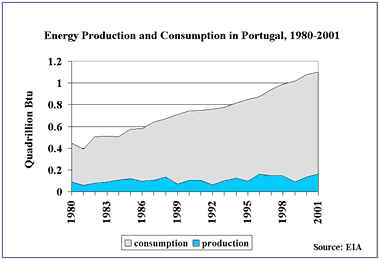 OIL
OIL
Portugal holds no proven commercially viable oil reserves. In 2002, the
country consumed 351,000 barrels per day (bbl/d), all of which was imported.
Oil made up 64% of the total Portuguese primary energy consumption for
that year.
Exploration and Production
Despite decades of exploration activity, Portugal has yet to discover
a commercially viable oil deposit. In 2002, the Portuguese government
offered 14 deep-water-offshore blocks for exploration and production contracts.
After the licensing round expired on December 2, 2002, only Repsol-YPF,
in partnership with RWE of Germany, made bids for Blocks
13 and 14. Taurus Petroleum of Sweden is currently the only other
company which holds an active offshore license.
Refining/Downstream
Portugal has two refineries, located in the coastal cities of Sines and
Porto. Petrogal operates the two refineries, which have a combined capacity
of 304,174 bbl/d.
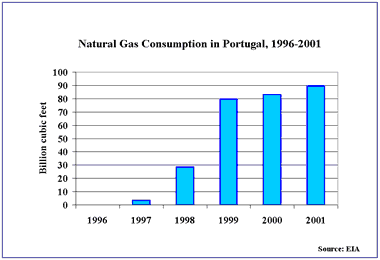 NATURAL
GAS
NATURAL
GAS
The Portuguese natural gas sector has grown considerably in the last few
years, despite lacking any commercially viable reserves. Annual consumption
was nearly non-existent prior to 1997 when the country consumed 4 billion
cubic feet (Bcf). In 2001, consumption reached 90 Bcf. The increase in
natural gas consumption can be attributed to the completion of the Maghreb-Europe
pipeline in 1996, which connected the Iberian Peninsula to Algerian natural
gas sources. Transgas spent $35 million to create a link, allowing Portugal
to import Algerian gas through Spain. Gas de Portugal owns the entire
Portuguese section, and part of other sections. Portugal (with EU assistance)
is making large investments in its natural gas infrastructure, having
spent approximately 485 million euros between 1994 and 1999. Since 1999,
the government has curtailed this spending somewhat, but there are still
plans to expand the natural gas network from 3,761 miles in 1999 to 5,943
miles in 2010.
Exploration and Production
Mohave Oil and Gas Company and Desire Petroleum PLC made Portugal's first
significant natural gas discovery at Alijubarrota. However, in June 2001,
Desire Petroleum plugged the Alijubarrota 2 sidetrack natural gas well
because, according to the company, the zone had "failed to produce
commercial quantities of hydrocarbon gases during underbalanced drilling
operations."
Liquefied Natural Gas (LNG)
In 1998, Portugal became an LNG purchaser for the first time. In 1999,
the country signed a 20-year contract with Nigerian LNG. Portugal is also
building its first LNG terminal in Sines, which will go online in late
2003 as a gas-processing facility. Until that time, LNG will continue
to be regasified in Spain and piped into Portugal.
Storage
Transgas, Portugal's natural gas transport company, plans to convert two
large salt caverns into storage tanks, with construction beginning this
year. The first two salt caverns will have a capacity of 2.1 trillion
cubic feet (Tcf). Transgas will convert two additional caverns in 2004,
doubling the storage capacity.
COAL
Portugal has not produced coal since its last mine closed in 1994. It
does import relatively small amounts of coal for electricity generation,
especially in periods of decreased hydropower. Although hydropower increased
in 2001, annual coal consumption fell only slightly in 2001 as electricity
demand increased overall.
ELECTRICITY
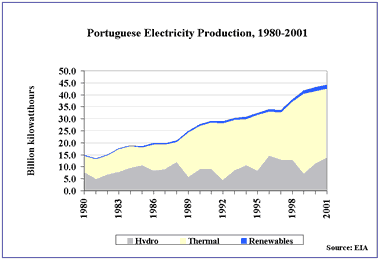 In
2001, Portugal consumed 41.5 billion kilowatthours (Bkwh) and generated
44.3 Bkwh of electricity. Hydropower accounted for about 31.4% of Portugal's
total electricity generation in 2001, a substantial increase from 17%
in 1999, a year characterized by particularly dry weather. Likewise, Portugal's
oil and coal consumption for power generation fell in 2001 to about 64.5%
from 79%; thermal power and hydropower tend to exhibit an inverse relationship
in Portugal (see graph).
In
2001, Portugal consumed 41.5 billion kilowatthours (Bkwh) and generated
44.3 Bkwh of electricity. Hydropower accounted for about 31.4% of Portugal's
total electricity generation in 2001, a substantial increase from 17%
in 1999, a year characterized by particularly dry weather. Likewise, Portugal's
oil and coal consumption for power generation fell in 2001 to about 64.5%
from 79%; thermal power and hydropower tend to exhibit an inverse relationship
in Portugal (see graph).
During the 1990s, installed capacity for both hydropower and thermal (coal, oil, and natural gas) grew, 36% and 47% respectively. While installed capacity for fuel oil decreased during the period, natural gas, which did not become a major source for electricity generation until 1998, increased. As of 2000, installed capacity for natural gas represented over 10% of total installed capacity and is expected to increase.
The Portuguese electricity grid is connected with Spain's and consists of 44,127 miles of high/medium voltage transmission lines and 69,640 miles of low voltage transmission lines. Up to 10% of demand could potentially be imported from and/or through Spain (and vice-versa). Despite rapidly increasing energy consumption (6% per year average 1973-1998), Portugal still has the lowest per capita power consumption in the EU, as of 2001. Portugal's electricity market is due to be fully opened to competition by July 2004.
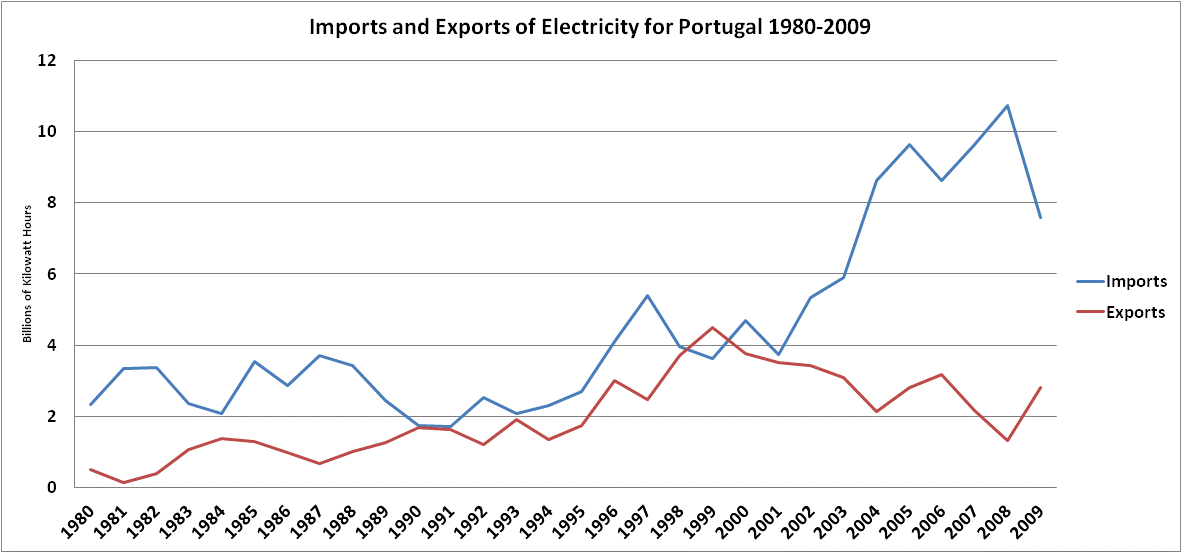
Iberian Integration
In November 2001, Spain and Portugal signed an agreement that calls
for complete integration of their electricity markets, creating the Mercado
Ibérico de Electricidade (MIBEL). MIBEL was scheduled to
be opened in early 2003, but both governments agreed to complete incrementally
the market in stages by 2006. The integration of the markets includes
creating a single market operator to negotiate the sale of electricity,
a merger of logistics networks, and increased interconnection of the
countries'
grids. In addition, all companies will operate under the same competition
guidelines, and tariffs will be harmonized.
Sector Organization
Since 1993, there have been independent power producers in Portugal, and
by 1998 they accounted for 28% of the country's power production. There
are two electricity systems in Portugal, the Public and the Independent.
The Public system is heavily regulated to ensure a guaranteed supply.
In the Independent system, competition has been introduced (in line with
EU directives), but is an option only for large consumers of electricity.
In the Public system, the 70%-state-owned/30%-EDP-owned grid operator
REN has exclusive and obligatory contracts with suppliers at a price expected
to cover costs. In the Independent system, there are no power purchase
agreements; consumers can choose their supplier, though the REN transmission
system is still used. Erse is the Portuguese independent electricity regulator.
Since January 2002, the government no longer has any power over electricity
tariffs. Rather, Erse makes the final decision after receiving a recommendation
from a council equally composed of consumer groups and the electricity
companies.
Electricidade de Portugal (EDP) is Portugal's largest electricity company. EDP has been progressively privatized in recent years. The Portuguese government still retains a 30% stake in the company, but plans to sell its remaining stake in EDP in 2004.
The signing of the MIBEL in November 2001 spurred a number of deals in the Iberian countries' electricity sectors. In December 2001, EDP acquired a 40% share of the holding company that owns 95% of Spanish utility Hidrocantabrico. EDP, as the senior partner, took control of Hidrocantabrico's operations, giving the Portuguese company a large foothold in the Spanish market. In March 2003, EDP also acquired a 62% stake in Naturcorp, the natural gas distributor in Spain's Basque region. EDP plans to merge Naturcorp with its Gas de Austurias, making EDP one of the largest natural gas companies in Spain.
In October 2002, Spain's largest utility, Endesa and Portugal's industrial holding company Sonae launched a 50:50 joint venture company, Sonae Comercialización de Energía (SODESA). The company aims to achieve a 15% share of the large consumer market.
With rising electricity demand and large-scale hydroelectric power already maximized, Portugal will most likely have to build more thermal plants, increase imports, or rely more on renewable sources of electricity such as wind, solar, co-generation, and mini-hydroelectric plants. The Portuguese government aims to increase electricity generation from renewable sources by 40% during the period 2002-2010. Portugal produced 1.8 Bkwh from renewable sources (excluding hydro) in 2001.
Nuclear Power
Portugal has no nuclear power plants. While there has been some interest
and discussion regarding the construction of a nuclear plant, there has
been no action toward this end.
COUNTRY OVERVIEW
Head of State: President Jorge Sampaio (since 1996; re-elected
in 2001)
Prime Minister: José Manuel Durão Barroso (elected March 2002)
Independence: 1143; from Spain 1640 (republic proclaimed October
5, 1910)
Capital City: Lisbon
Population (2002E): 10 million
Location/Size: Southwestern Europe, bordering the North Atlantic
Ocean, west of Spain/92,391 sq km (slightly smaller than Indiana)
Language: Portuguese
Religion: Roman Catholic 97%, Protestant denominations 1%, other
2%
ECONOMIC OVERVIEW
Finance Minister: Maria Manuela Dias Ferreira Leite
Currency: Euro
Exchange Rate (June 2, 2003): 1 US Dollar = 0.854 Euros
Gross Domestic Product (GDP, nominal, 2002E): $121.3 billion
Real GDP Growth Rate (2002E): 0.5% (2003F): 0.4%
Inflation Rate (consumer prices, 2002E): 3.6% (2003F):
2.9%
Unemployment Rate (2002E): 5.0%
Merchandise Exports (2002E): $25.6 billion
Merchandise Imports (2002E): $38.4 billion
Major Trading Partners: Germany, Spain, France, United Kingdom
Major Export Products: textiles, footwear, leather goods, machinery
and transport equipment, wood and cork, agricultural goods and foodstuffs
Major Import Products: Machinery and appliances, agricultural products
and byproducts, chemical and plastic products, land transport equipment,
mineral products
ENERGY OVERVIEW
Minister of the Economy: Carlos Manuel Tavares da Silva
Proven Oil Reserves: None
Crude Oil Production (2002E): None
Oil Consumption (2002E): 351,000 (bbl/d)
Crude Oil Refining Capacity (1/1/03E): 304,172 bbl/d
Natural Gas Reserves: None
Natural Gas Consumption (2001E): 90 billion cubic feet
Coal Reserves (2001E): 40 million short tons (Mmst)(no longer mined)
Coal Consumption (2001E): 6.7 Mmst
Coal Production (2001): None since 1994
Electric Generation Capacity (2001E): 10.3 gigawatts
Electricity Generation (2001E): 44.3 billion kilowatthours (thermal
64.5%; hydro 31.4%; biomass, geothermal, solar, and wind 4.1%)
Electricity Consumption (2001E): 41.5 billion kilowatthours
ENVIRONMENTAL OVERVIEW
Minister for Cities, Environment and Planning: Amilcar Teias
Total Energy Consumption (2001E): 1.1 quadrillion Btu* (0.3% of
world total energy consumption)
Energy-Related Carbon Emissions (2001E): 16.25 million metric tons
of carbon (0.3% of world total carbon emissions)
Per Capita Energy Consumption (2001E): 108.6 million Btu (vs. U.S.
value of 341.8 million Btu)
Per Capita Carbon Emissions (2001E): 1.62 metric tons of carbon
(vs. U.S. value of 5.5 metric tons of carbon)
Energy Intensity (2001E): 8,251 Btu/$1995** (vs U.S. value of 10,736
Btu/$1995)
Carbon Intensity (2001E): 0.12 metric tons of carbon/thousand $1995**
(vs. U.S. value of 0.17 metric tons/thousand $1995)
Fuel Share of Energy Consumption (2001E): Oil (64%), Coal (11%),
Natural Gas (9%) Hydro (13%) Other renewable (3%)
Fuel Share of Carbon Emissions (2001E): Oil (73%), Coal (18%),
Natural Gas (9%)
Status in Climate Change Negotiations: Annex I country under the
United Nations Framework Convention on Climate Change (ratified December
21st, 1993). Signatory to the Kyoto Protocol (signed April 29th, 1998
and ratified May 31, 2002).
Major Environmental Issues: Soil erosion; air pollution caused
by industrial and vehicle emissions and water pollution (especially in
coastal areas).
Major International Environmental Agreements: A party to Conventions
on Air Pollution, Biodiversity, Climate Change, Desertification, Endangered
Species, Hazardous Wastes, Law of the Sea, Marine Dumping, Marine Life
Conservation, Ozone Layer Protection, Ship Pollution, Tropical Timber
83 and Wetlands. Has signed, but not ratified: Air Pollution-Persistent
Organic Pollutants, Air Pollution-Volatile Organic Compounds, Climate
Change-Kyoto Protocol, Environmental Modification, Nuclear Test Ban, Tropical
Timber 94.
* The total energy consumption statistic includes petroleum, dry natural
gas, coal, net hydro, nuclear, geothermal, solar, wind, wood and waste
electric power. The renewable energy consumption statistic is based on
International Energy Agency (IEA) data and includes hydropower, solar,
wind, tide, geothermal, solid biomass and animal products, biomass gas
and liquids, industrial and municipal wastes. Sectoral shares of energy
consumption and carbon emissions are also based on IEA data.
**GDP based on EIA International Energy Annual 2001
Sources for this report include: BBC Worldwide Monitoring; CIA World Factbook; Diario de Noticias; Global Insight; Economist; Economist Intelligence Unit; Electricidade de Portugal; Europe Information Service; European Union; Financial Times; International Energy Agency; Petroleum Economist; Petrogal; U.S. Energy Information Administration.
For more information from EIA on Portugal, please see:
Portugal
Country Data
Links to other U.S. Government Sites:
CIA
World Factbook - Portugal
U.S. State Department
Consular Information Sheet - Portugal
U.S. State
Department Country Commercial Guide - Portugal
U.S. State Department Background Notes - Portugal
U.S. Embassy in Portugal
The following links are provided solely as a service to our customers and should not be construed as advocating or reflecting any position of the Energy Information Administration (EIA) or the United States Government. EIA does not guarantee the content or accuracy of any information in linked sites.
Galp
Electricidade de Portugal
European
Commission Directorate General XVII (Energy)
Geological and Mining Institute of Portugal
Regulatory Entity of the Electric Sector
- ERSE
If you liked this Country Analysis Brief or any of our many other Country Analysis Briefs, you can be automatically notified via e-mail of updates. You can also join any of our several mailing lists by selecting the listserv to which you would like to be subscribed. The main URL for listserv signup is http://www.eia.doe.gov/listserv_signup.html. Please follow the directions given. You will then be notified within an hour of any updates to Country Analysis Briefs in your area of interest.
Return to Country Analysis Briefs home page
File last modified: June 2, 2003
Contact:
Charles Esser
Phone: (202) 586-6120
Fax: (202) 586-9753